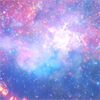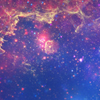CXC Home | Search | Help | Image Use Policy | Latest Images | Privacy | Accessibility | Glossary | Q&A
Tour of Multiwavelength Galactic Center
Quicktime MPEG
This never-before-seen view of the turbulent heart of our Milky Way combines a near-infrared view from Hubble, an infrared image from Spitzer, and X-ray data from Chandra. The composite image features the spectacle of galactic evolution: from vibrant regions of star birth to young and old stellar populations and even to the eerie remains of stellar death called black holes. All of this occurs against a fiery backdrop in the crowded, hostile environment of the galaxy's core, the center of which is ruled by a supermassive black hole. A diffuse haze of X-ray light from hot gas permeates the entire field. This gas has been heated to millions of degrees by outflows from the supermassive black hole as well as by winds from massive stars and stellar explosions.
[Runtime: 00:53]
Quicktime MPEG
This never-before-seen view of the turbulent heart of our Milky Way combines a near-infrared view from Hubble, an infrared image from Spitzer, and X-ray data from Chandra. The composite image features the spectacle of galactic evolution: from vibrant regions of star birth to young and old stellar populations and even to the eerie remains of stellar death called black holes. All of this occurs against a fiery backdrop in the crowded, hostile environment of the galaxy's core, the center of which is ruled by a supermassive black hole. A diffuse haze of X-ray light from hot gas permeates the entire field. This gas has been heated to millions of degrees by outflows from the supermassive black hole as well as by winds from massive stars and stellar explosions.
[Runtime: 00:53]
(Credit: X-ray: NASA/CXC/UMass/D. Wang et al.; Optical: NASA/ESA/STScI/D.Wang et al.; IR: NASA/JPL-Caltech/SSC/S.Stolovy)
Pan of the Galactic Center
Quicktime MPEG
Data from NASA's Great Observatories has been combined to produce this unprecedented image of the central region of the Milky Way. Near-infrared light from Hubble (yellow) outlines energetic regions where stars are being born. Infrared data from Spitzer (red) show glowing clouds of dust containing complex structures. And, X-rays from Chandra (blue and violet) reveal gas heated to millions of degrees by stellar explosion and outflows from the Galaxy's supermassive black hole.
[Runtime: 01:00]
Quicktime MPEG
Data from NASA's Great Observatories has been combined to produce this unprecedented image of the central region of the Milky Way. Near-infrared light from Hubble (yellow) outlines energetic regions where stars are being born. Infrared data from Spitzer (red) show glowing clouds of dust containing complex structures. And, X-rays from Chandra (blue and violet) reveal gas heated to millions of degrees by stellar explosion and outflows from the Galaxy's supermassive black hole.
[Runtime: 01:00]
(Credit: X-ray: NASA/CXC/UMass/D. Wang et al.; Optical: NASA/ESA/STScI/D.Wang et al.; IR: NASA/JPL-Caltech/SSC/S.Stolovy)
Return to Galactic Center (November 10, 2009)




